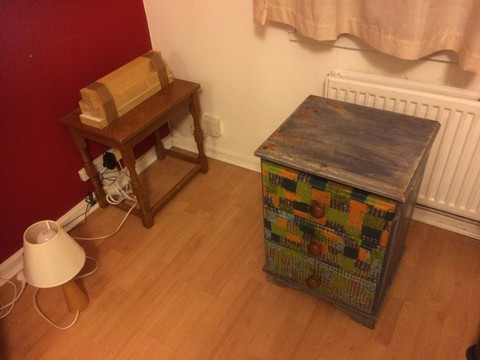COVID-19 lockdown and university closure
- Oliver Haigh
- Mar 24, 2020
- 7 min read
The last week or so has seen a rapid change at the national level and also at the university level, due to the rapid escalation of the COVID-19 situation. The latest on the situation now is that the whole of the UK is in lockdown, and all university buildings are closed.
Impact: model-making
I approached the start of last week believing that it would only be a matter of time until the university buildings would be closing, even though there hadn't been any official information indicating this.
As a result of this, I decided to make the most of the workshop as much as I could, to make as many models for studio and technology as possible. I knew that some of the fabric formwork tests could possibly be carried out in my flat, but it would be hard without access to tools like clamps etc, and without the expertise of the workshop staff. Another of the models that I was working on required the use of a laser cutter and a power drill, so I prioritised this.
Examples of some of the workshop facilities that I will be lacking – basic tools such as clamps (left) and specialist machinery like laser cutters (right)
I had thought that I would have had days access in the workshop, but in the end the workshop closed at the end of Thursday. Thankfully, I had managed to done get most of what I had wanted to. The workshop staff were still around on Friday for us to purchase materials, so I bought 10kg of fine casting plaster (the material I have been using for all of my fabric formwork tests) and six rolls of Modroc. I don't know how much of this I will need, but with the university closure being such an open-ended thing, I felt it better to buy more than I would probably need, in case the closure lasts until the end of my course.
Impact: computer hardware
For the whole time that I've been on this course, I've done all of my work in the studio or library, always using university computers, which have good processing power, large screens and all of the software required for my needs. I haven't done any architecture work on my laptop since my undergraduate.
I am lucky that my laptop is of an okay specification, and I have now been trying to get hold of student versions of software so that I am able to keep working the same way that I would in studio. From my first attempts using my laptop in these last few days, it does seem to be quite a bit slower than using uni computers, and I think that I'm not going to be able to run several programs at the same time, which is frustrating for my workflow. Also, it is going to take some getting used to working on a screen that is about a quarter of the size of the ones that I've been using in university, especially as a lot of architecture software has lots of toolbars around all four sides of the screen. I'm sure that I will get into the swing of it, it will just be a period of adjustment.
Impact: printing, scanning and plotting
Something completely missing in my home-working environment is access to printers, scanners and plotters. I think that this will not be too big an issue for me, as I don't use them all that regularly in university. If I need to trace over things, I will just have to carefully do so over my laptop screen, and in place of scanning, I can photograph pages and then touch them up in photo-editing software.
Impact: studio culture
I think that moving from studio working to working from home is going to affect a lot of people within our Field Works studio quite a lot. There is a group of us who are in every day, and we regularly share ideas and ask for each others opinions and input on the work that we are doing. Our studio is also the one most focused on physical making and tasting, which, as mentioned above, is going to take a real hit without access to university facilities.
Impact: workspace
I am very aware of how lucky we are on the masters programme here at Leeds Beckett in terms of the amount of studio space that we have for a relatively small course. Everyone has their own working area and computer workstation, and space for making and storing models, meaning that we can easily pick up where we left off from day to day, without having to pack everything up each day like in a hot-desking scenario.
It is fair to say that since September, I have really settled into my working space, and have gradually adapted it to best suit my needs. As I have accumulated more and more models, I have erected makeshift shelves to store them, and I have also built up a collection of quite a lot of materials that I have bought or found in the workshop, and some that I have brought in from my flat.
Video taken in January showing my studio set-up – iMac workstation, timetables and checklists on the wall, model-making desk, place for taking model photos whilst borrowing one of the university lights, shelves for storing models below this [note – by now the photography area had filled up with more models and I was using a different area of the studio for photographing models]
In contrast to this ideal set-up, in my flat I haven’t had any space set up for working at all, as I do all of this in university. This is something that I’ve now been trying to adapt.
Role as course representative
As course rep for MArch2, I’ve spent time over this last week trying to help out our year as a whole, by collecting everyone’s worries and issues and then taking them to the tutors. As well as exchanging emails, I’ve had two meetings with George Epolito, our course director, to share these issues, discuss possible ways around them, and then feed back information to the rest of the class.
Although this has been time-consuming, when I ideally would have been focusing on my imminent Technology module (the deadline for which has now been extended for everyone), it has definitely been a worthwhile endeavour that I am glad to have done. As everyone is dealing with different situations at the moment and different worries, both of academic issues, and of more important issues of the health and wellbeing of themselves and family, friends and flatmates, it has good that the tutors have got a better understanding of what these issues are.
Transitioning to home-working
I am fortunate to have parents with a car who live just over an hour away, and they very kindly agreed to come and help me move out some of my things from studio at the end of last week, so that I would be able to have as many of my models and model-making materials at home to aid my continuing project work. This was lucky, as I had been carrying home a few things every night when leaving studio last week, but most of my models were either too heavy or too fragile to be carried back to my flat by walking.

Photo of me at my desk just before leaving studio on the last day of studio being open, with most of my things already removed and just a few last models to carry downstairs
The last use that I made of workshop power tools before it closed down, was to cut some spare pieces of MDF that I had to make extra shelves to store some of the models in my flat. There was some spare space in my wardrobe, so I measured that up and measured up my models to make sure that they would fit. I am really happy with this, as it means that my fabric formwork test are now safely stowed away and shouldn’t get damaged, and I also have more free worktop space for working.
Fabric formwork tests stored in new pull-out shelves in my wardrobe
More importantly than sorting model storage in my flat, I needed to set up some sort of desk for myself to work at. My flat has got an attic which is full of rubbish from the landlord and previous tenants, so I had a look in there to see what I could find.
At first, I found a couple of sheets of thin plywood which I rested between a bedside table and a lower table with some pieces of wood propped on top to make it the same height. This wasn’t great, as the plywood was too thin and would bow under any pressure like writing or typing on it.
Hunting deeper into the recesses of the attic, I found a spare offcut of the kitchen worktop, which seemed perfect. I’ve now got that installed on top of the same tables and so far it seems to work well and be a good height. I’m hoping that it won’t collapse with my laptop on it anytime soon!
Creating a makeshift desk – first version using plywood (top left), final version using an offcut of worktop laid across two small tables and some pieces of wood (others)
Reflection and looking ahead
Now that I am set up fairly well with working space, model making materials, and most of my most relevant models with me in my flat, I am feeling a lot better about the situation than I was a few days ago, even though it is still clearly not ideal.
My main worry now is being able to focus and maintain my work ethic within the home environment, as for the last year and a half this has basically been my place away from my studies. I’m particularly concerned because I tried to work from home a lot in my undergraduate years, which was not a very successful experience. I have much preferred working in the studio and workshop on my masters, and have definitely been producing better work and at a much better work-rate. I think it’s inevitable that it will take a while to adapt now, but I am hoping that I am able to find a way soon, as it would be a real shame for this to impact negatively on my masters degree at this final hurdle.
Setting this in its bigger context, I am obviously aware that there are much more important issues going on right now, and that people are in really dangerous and unfortunate situations right now with COVID-19, so I am grateful for my health and for the work of all of the key-workers who are not able to work at home. I think that as a group of students we all need to keep focusing on that, and accept that we can only achieve what is possible under these more limited working conditions.
















Comments